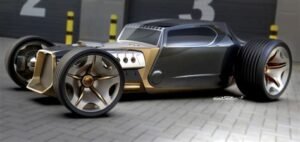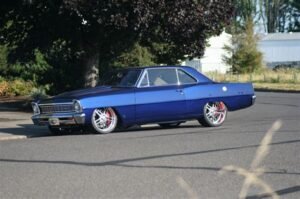
Restoration of a classic car is a labor of love-a backward journey in time to give a new lease on life to an automobile historic artifact.
While the dividends from a successful restoration are great, the route is paved with difficulties that will surely try your patience, skills, and even budget. In this article, we go into the details of the classic car restoration and look at some common problems that you may be facing and how you can find your way out of them.
The Search for the Perfect Project
The right car is the first challenge in any classic car restoration project. Finding this may be about patience and a knack for recognizing potential. The ideal project car will balance your personal wants, your budget, and your goals regarding restoration.
Condition Evaluation
The first thing one can do before undertaking any restoration work is to thoroughly examine the status of the car in one’s hand. This needs a detailed examination of the body, chassis, engine, transmission, and interior. Check for any signs of rust, damage, or missing parts and, in general, any other problem that could possibly impact the whole restoration process.
Rust and Corrosion:
Common problems one would encounter with classic car restoration include rust and corrosion. These could compromise structural integrity, which might be intensive to fix using major repairs or replacement parts. Detailed inspection and professional assessments are required in defining the extent of the rust damage and hence correctly plan for its repair.
Missing or Damaged Parts:
The search for spare parts for classic cars is a chore that can drive anyone to the brink of insanity. Some spares are available on store racks while others may involve days of painstaking research and possibly very expensive sourcing. Check the availability of spares available for the particular model that you intend to restore before embarking on the restoration work.
Scope of Restoration
In light of appraising the condition, you will need to define the scope of restoration. Are you going to do a full-scale restoration, returning the car to factory specs, or is it going to be a milder restoration, touching only on the necessary repairs and improvements that are needed?
Full Restoration:
A full restoration goes to the greatest extent to return the car to its original state. In this case, it involves the complete disassembly of the car and the repair or replacement of every component included in it, followed by a careful reassembly based on factory specifications. Although very satisfying, a full restoration is also the most time-consuming and costly alternative.
Moderate Restoration:
The moderate restoration usually includes necessary repairs alone, such as rust issues, mechanical problems, and cosmetic improvements. These could include modern replacements for some parts or the modernization of specific systems for improved performance and/or reliability. In this way, moderate restorations balance between restoration goals and budgetary constraints.
The Budget Line
A classic car’s restoration is both an emotional and financially rewarding investment; however, being realistic about the costs involved is quite significant. The financial aspect of the restoration challenge is one that requires careful planning and budgeting.
Estimating Costs
A correct estimation of the restoration costs will ensure the success of the project. Consider the cost of the car, the needed repairs, replacement parts, painting and bodywork, labor, and extra costs that may be incurred, including but not limited to special tools, equipment, and storage. It is always good to overestimate costs due to unforeseen expenses that may arise during a delay in work.
Budget Breakdown:
- Purchase Price: The cost of the car itself is the foundation of your restoration budget.
- Repair Costs: Provide estimates for rust repair, mechanical repairs, and other needs for complete restoration.
- Parts: Search for availability of replacement parts and their cost, considering the potential difficulty in finding rare or no-longer-manufactured items.
- Labor: If some of the work is going to be subcontracted, include labor costs for mechanics, body shops, and other experts.
- Other Costs: Allow for tools, equipment, storage, shipping and other sundry expenses.
Financing Alternatives
Based on your financial position you may consider the alternative sources of funds available to finance your restoration project.
Personal Savings:
If you have enough savings using your own funds may be an uncomplicated and controlled manner in which to finance your restoration. But be certain not to overextend yourself financially.
Loans:
Personal loan or classic car restoration loan: Consider taking a personal loan or one specifically granted for classic car restoration. While these will deliver the required amount, it is very important to carefully go through the loan terms, interest rates, and repayment schedule.
Investment:
If one is of the opinion that the project of restoration will result in a great increase in value of the car, then invest in the same with the help of interested individuals or institutions. This requires great deliberation on the terms of investment and return on investment.
Time Commitment
This area requires immense commitment and is thus very time-consuming. A restoration can take anything from some months – depending on how simple the project is, to several years in the case of an extensive restoration.
Planning and Organization
Time planning and organization are very important in managing how long a restoration can take. Make a detailed schedule, divide the project up into subtasks, and set realistic deadlines. Documenting parts lists and progress updates will help you stay organized.
Patience and Persistence
Restoration of a classic car is a marathon, not a sprint. Even the best-laid plans cannot avoid setbacks. Sometimes, life gets in the way or the method of choice does not work as expected. Or, often worse, a setback may arise when one least expects it. But flexibility, patience, and persistence will reward a restorer’s unwavering goal to successfully complete restoration projects. After all, every accomplished task you do brings you closer to your aspired goal.
Professional Help
While some of the restoration work can be done without professional help by an amateur owner who is competent with the appropriate tool and equipment, at times not all work can be done in-house. For instance, if you have no experience in bodywork or paint or in working on engines, consider getting professionals to get it done to assure quality and accuracy that may lead to costly mistakes.
Table of Typical Restoration Timeframes:
| Task | Estimated Time (Hours) |
|---|---|
| Bodywork and Paint | 200-500 |
| Engine and Transmission Overhaul | 100-250 |
| Interior Restoration | 50-150 |
| Chasis and Suspension Repair | 50-150 |
| Electrical System Rewiring | 50-150 |
These are rough estimates, and the time required for each may very well depend on the condition of the car, the complexity of the tasks, and your skill level. Remember, restoration is a journey, and the time put in is part of that.




